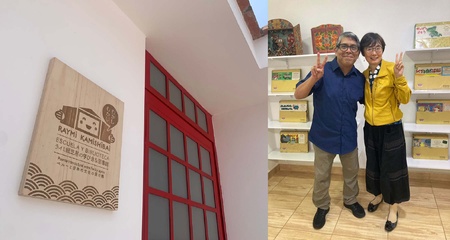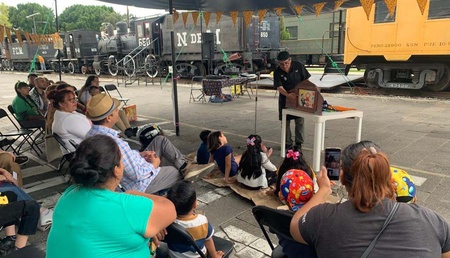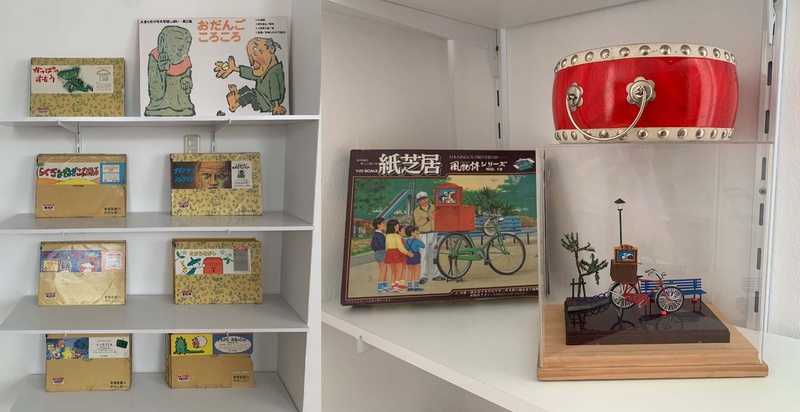There are initiatives that start with a name, with a man. Raymi Kamishibai is the first school and library for kamishibai, Japanese paper theater, directed by Pepe Cabana Kojachi, a Peruvian Nikkei of Ayacucho and Okinawan descent who mixed this technique in his art to tell stories for children with the aesthetic element of altarpieces, a type of wooden chest that brings together characters that stage a tradition from Andean Peru, to spread the work of their proposal “Mukashi, Mukashi” (which means “a long, long time ago”).
On board a bicycle and also in a portable table format, Pepe takes his paper theater and performance to different districts of Lima, regions of Peru, cities around the world and more. This was 21 years ago, when he began his story-telling journey that has taken him to visit several countries in South America, North America, Europe and Asia. “Reading allows us to create, it allows us to dream, and teamwork and self-management allow us to make it a reality,” is the motto of “Mukashi Mukashi.”
“Kamishibai school and library is now a reality. Having received a considerable donation of Japanese kamishibai publications gave us the impetus to create this space,” says Pepe Cabana Kojachi, who on September 22 just inaugurated the first school and library dedicated to this form of oral and illustrated narrative in the Chorrillos district in Lima, Peru, with the valuable contribution of the Chigasaki Library.

School and library
Together with his family, they built this pioneering space in Peru and Latin America for the exhibition of kamishibai publications and other related objects that Pepe has been collecting on his various travels; as well as an area for workshops that can be given to all school teachers, education students and parents interested in Japanese culture and kamishibai.

And, thanks to the support of many colleagues and friends who have received him when he has brought his work and experience with Japanese paper theater, pedagogy and the role of the storyteller, they decided to consider within the facilities a room for their foreign guests. “The idea is to carry out training, research and activities with them on kamishibai, illustration, reading mediation, among others.” For example, at the end of October they will receive Tara M. McGowan, a renowned kamishibai researcher and promoter, who will arrive from the United States.
The day they inaugurated the school and library, they screened the documentary “Mukashi, Mukashi on the Kamishibai Route, Japan”, produced and directed by Pepe Cabana in Japan, being the first audiovisual material made in this country and in the world that seeks to give to know the heart and spirit of kamishibai and which has been presented in person in Chile, Bolivia and Mexico.
“The opening day was very significant. Chikako Yamawaki, a friend and collaborator of our project, came especially from Japan to be the godmother. Now we begin a new story on the path we have been taking,” says Pepe. Just a few days later, “Mukashi Mukashi” traveled as a team with Tatiana Ugaz, activities coordinator and international liaison, to Puebla, Mexico, to perform at the V International Meeting “Yolotl: stories that beat”, where he took the kamishibai, to continue sharing stories and managing projects for 2024.

Cultural Management
Pepe Cabana Kojachi says that he has the hope and projection of organizing a Kamishibai School Festival that complements the teacher training that he has been carrying out in educational institutions, and that he hopes to take to a higher level next year.
“We will continue managing projects to strengthen identity, culture, education and reading mediation through kamishibai. We are sure that we will find various allies along the way who contribute to achieving the objectives and always working as a community.”
The Raymi Kamishibai School and Library will contribute to the training, dissemination and research on the art of kamishibai, says Pepe Cabana Kojachi, who hopes that this independent and self-managed space will provide all its visitors with a great experience that brings them closer to reading.
© 2023 Javier García Wong-Kit






